Paronychia
What is a Paronychia?
A paronychia (which is Latin for "infection in the region of the nail") is an infection around the edge of the nail plate (the part that you cut with a fingernail clipper). Look at the photo below and you can see how the infection goes all around the edge of the nail, at the upper side of the picture (it does not go to the side where you cut the fingernail).
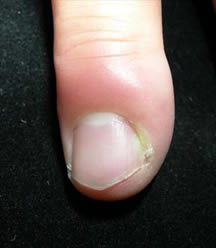 |
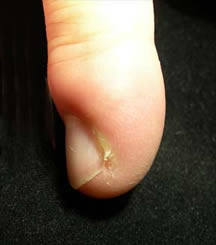 |
| This fingertip is red, swollen, and hurts: it is a paronychia! Note how the redness and swelling goes around the nail. Also note the small white area at the edge of the nail plate. This is not often seen, but when it is, you know the paronychia has progressed to the second stage, an abscess. | |
Felon
A felon is different kind of infection in the pulp space, on the side of the finger with the fingerprint. Both of these infections have special aspects, due to how the fingertip is constructed. See my page on felons.
The first stage of the infection: Infected fingers start out with the bacterial invading your tissues, and causing the generalized tenderness, swelling, and redness. This is called cellulitis, which is Latin for "infection of the cells".
The second stage of the infection: As the battle goes on and the bad guys start winning, the battle causes a pocket of pus (the white cells your body is using to fight the bacteria) to form. This is called an abscess.
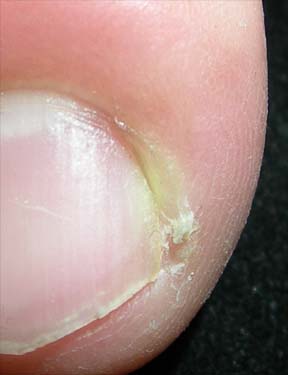
This close-up of the fingertip above shows a
paronychia that is in the second stage,
an absess, which is the white at
the edge of the nail.
Treatment of a Paronychia
The treatment of a paronychia depends on many things, but basically it boils down to the stage of the infection.
Stage 1, cellulitis, can often be treated with hot soaks (5 times a day, for 20 minutes).
Hot Soaks
If you soaked your hand in hot water, it would turn red, right? This is because there is an increased blood supply. Since blood supply is how we get our white cells (infection fighters) to the site of the battle, increasing blood supply is a good idea. The hot soaks do this. Hot soaks consist of putting the hand into very warm water: not hot enough to hurt, but hot enough to make the hand very red. Hot tap water is usually hot enough, and cool it down with cold if you have to. The red means that there is a lot of increase blood flow to the hand, bringing the body's natural infection-fighting cells to the site as well as lots of antibiotics. The soaks should be about 20 minutes long, and often the hot water needs replacing. If it cools off before the 20 minutes is up, put more hot water in. Additives such as epson salts or betadyne are not needed if the skin is not broken, but some patients like to add them anyway. The hot soaks should be repeated five times a day.
Stage 2, an abscess, needs to be treated by a hand surgeon, who will numb up your finger and make a small cut, about 1/4 of an inch in size, directly into the abscess. This needs to be done to let the pus out. The abscess does not have a blood supply (it is just a pool of pus), so the hot soaks alone will not do it.
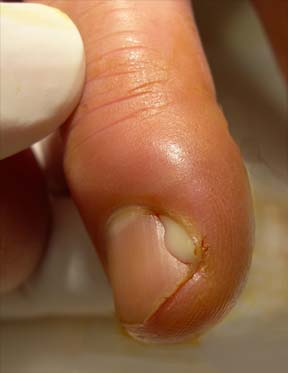
A small cut has been made and the pus is coming
out. The fingertip is about to get better!
After the pus has been let out, hot soaks will help to bring blood supply to the surrounding tissues.
Oral antibiotics (antibiotic pills) will help the body fight the infection, and the hot soaks will bring more blood and antibiotics to the cells that need it.
Special conditions
If you have diabetes or any medical condition that affects your immune system, you are at a much higher risk for worse infections, so be sure to see your doctor right away if you think you are beginning to get a fingertip, or any other kind of, infection.
What if I don't get treatment?
If left untreated, fingertip infections can cause permanent damage to your fingertip and can get into your blood (this is called blood poisoning; the medical term is "ascending lymphangitis".) These can be serious, so don't fool around with your health: call your doctor for evaluation, advice, and treatment.
Followup
It is very important that you do your hot soaks and take your antibiotics as directed. Also, be sure to keep your follow-up appointment, so that I can be sure that you and your fingertip are winning the battle against the bacteria.
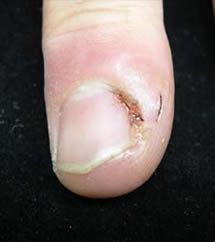 |
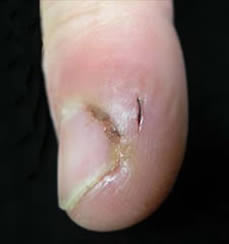 |
| This is the same fingertip, 2 days later, after drainage of the pus, oral antibiotics, and hot soaks Note that it is less swollen and less red, and the patient told me it hurt a lot less! | |
The first signs that your fingertip is getting better will be that the sharpness of the pain will decrease (the pain will not entirely go away, but the worst of it will go down, and you will be able to think of something besides your painful finger) and the sharpness of the redness will decrease (the redness will not entirely go away, but the color will change from a bright red to a duller red). It usually takes about 36 hours (a day and into the next day) for this to happen, once the proper treatment has been started. Don't let it alarm you if there is still some pain and redness. However, if you find that the pain is not going away or is getting worse the next day or so, or if the redness is expanding the next day or so, or if you are getting a fever (use a thermometer, don't guess, as we have a very limited ability to estimate a fever) or are feeling worse overall, you need to give me a call. Try to call during office hours if you can, but call anytime if you think it can't wait.
The finger will continue to be a bit swollen and a dull red for some weeks, but this is normal, as long as you see steady, but slow, progress. Be sure to take all of the antibiotics I prescribe for you and keep doing the hot soaks for about 2 days after you think it is much better. I will give you a followup appointment: please keep it, even if you think it is doing great, because I want to be sure it is healing properly.
Here is the page of my friend, Dr. Charles Eaton: Paronychia.
